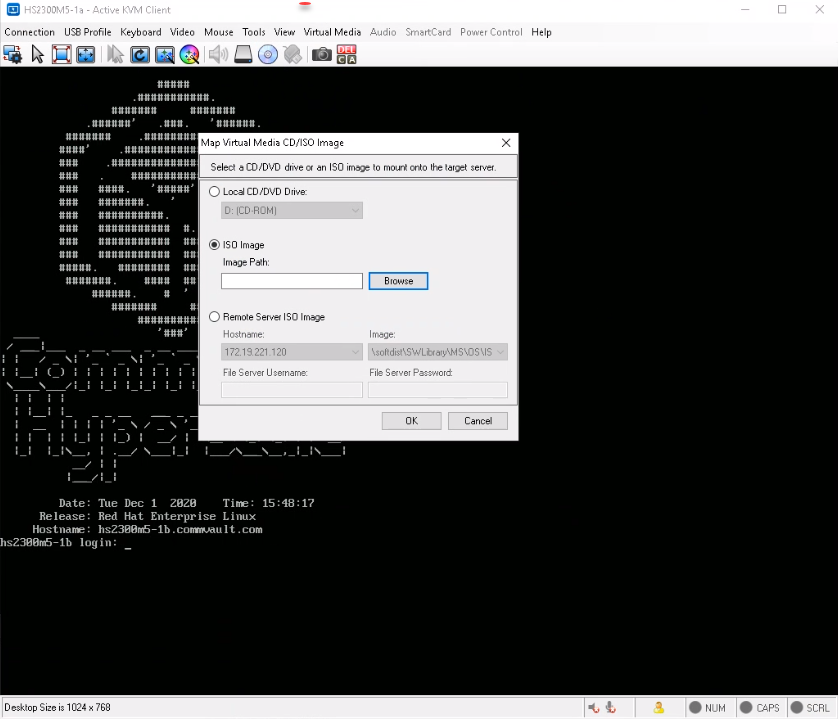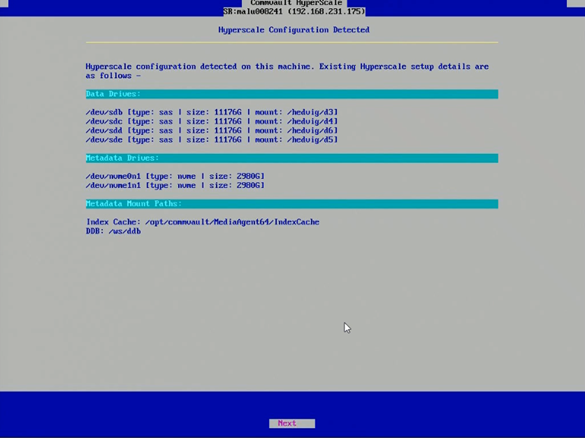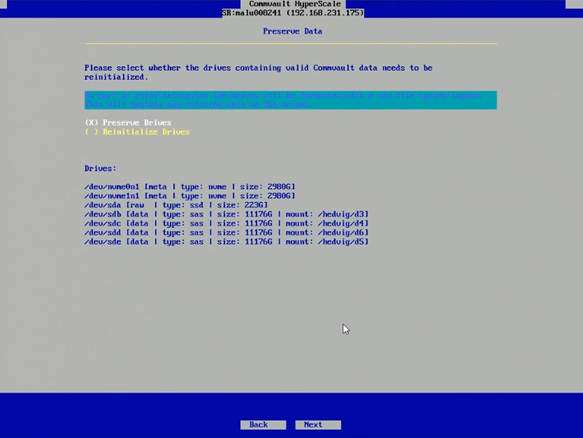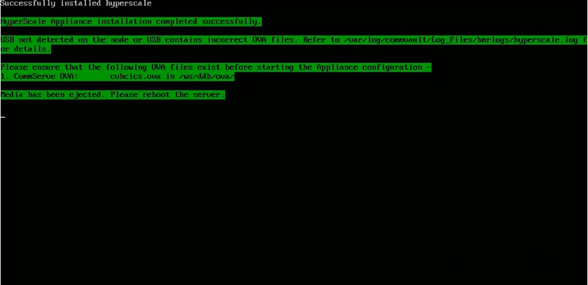Commvault HyperScale X nodes can be refreshed when there are hardware failures in an existing node in the storage pool, such as disk issues or corrupted operating system. When a node is refreshed, only the drive containing the operating system, which can be reinstalled and rebuilt, will be recovered. Data drives will be reconstructed using the other nodes in the storage pool and drives containing the Deduplication Database (DDB) and Index Cache will be preserved.
Support
Nodes with Backup Gateways pointing to an external CommServe can be recovered. (Nodes setup with both the CommServe and Backup Gateways not supported.)
Before You Begin
-
Enable root access, if root access is disabled in the storage pool. For more information, see Restricting Root Access on HyperScale X.
-
Verify that your environment meets the requirements that are mentioned in the Existing Node Requirements section in Prerequisites for Adding Nodes to an Existing HyperScale X Storage Pool.
-
Verify that multi-factor authentication (MFA) is enabled. Also, verify the following:
-
Verify that all nodes in the HyperScale cluster can access the following URLs:
- https://api.metallic.io, which is the endpoint used for all storage pool operations.
- https://<Saas-ring-name>.metallic.io/commandcenter, Commvault Cloud Console URL specific to your ring. For example, https://m01.metallic.io/commandcenter.
Both the URLs are on HTTPS and can be accessed through port 443.
-
Verify that users have a local CommCell account; if SAML authentication is used, create a new Local Tenant Admin account.
-
Procedure
-
Login to the Windows based computer.
-
Download the latest HyperScale Appliance ISO <Version_Number> (for example, HyperScale ISO 2.2) from Commvault Cloud Store.
-
Access the node using the KVM management console in your environment.
-
Map the downloaded ISO image as a virtual media from the KVM Management console.
Click here to view a sample image.

-
Reboot the node using the virtual media as follows.
-
Login to the node as root. (Press <Alt> + <Ctrl> + <F2> if the login prompt is not displayed.)
-
Type
reboot. -
During the boot sequence press <F12> when the following message is displayed. (This message will be displayed briefly for a few moments only during the boot sequence.)
Press F2 to enter Setup or <F12> to enter Boot Menu. -
Select the virtual media as the boot device and press <Enter>.
The Commvault HyperScale Install will be started.
-
-
The HyperScale Configuration Detected screen is displayed.

Choose Next.
-
The Preserve Data screen is displayed.

Choose the Preserve Drives option and then click Next.
The installation process will be started. This process will take some time to complete.
The following message will be displayed once the installation is complete.

-
Reboot the node.
-
After the reboot, login using the following default credentials:
Login: root
Password: cvadmin
(Press <Alt> + <Ctrl> + <F2> if the login prompt is not displayed.)
-
Verify that the contents of
/etc/hostsfolder is identical to the other nodes in the cluster, using the following command:# cat /etc/hosts -
Navigate to the following folder:
/opt/commvault/MediaAgent64/task_manager -
Run the following command on one of the existing cluster nodes other than the reimaged node:
./cvmanager.py -t Restore_NodeThe following message appears:
: Initializing HyperScale Task Manager. : Commvault HyperScale Task Manager Initialized. : No incomplete task data found for: Restore_Node Root password of existing cluster: [Re-Enter to Confirm] - Root password of existing Cluster: -
Enter the root password which was added during the initial Hyperscale node configuration. (This root password would be the same root password used in the other nodes.)
The following message appears:
Are you registering with SaaS (y/n): -
Enter y.
The following messages appear:
Enter the SaaS backup gateway for registration: Enter the SaaS backup gateway port for registration [443]:Enter the fully qualified host name and port of the existing backup gateway that you are connecting to.
-
Enter y.
The following messages appear:
Authorization mode: 1) Username & Password (Non-MFA) 2) Existing Access Token 3) Username & Password + PIN (MFA) Your Choice (1/2/3):Enter values for all the prompts. Authentication mode 2 - Existing Access Token is currently not supported.
-
If your organization has MFA enabled and you selected 3 for the authentication mode, the following prompts are displayed.
Enter the values.CommCell user name with permission to register clients and edit storage pools: CommCell's user password with permissions to register new clients: [Re-Enter to Confirm] - CommCell's user password with permissions to register new clients: PIN:- The username must be the email address of the user. Do not enter username in the format of <CompanyName>/Username.
- Enter the PIN generated by the authenticator tool that you use for multi-factor authentication
-
If your organization does not have MFA enabled and you selected option 1 for the authentication mode, the following prompts are displayed.
Enter the values.CommCell user name with permission to register clients and edit storage pools: CommCell's user password with permissions to register new clients: [Re-Enter to Confirm] - CommCell's user password with permissions to register new clients: -
The following message appears:
Enter the hostname of the node that you want to restore. The restore process is initiated and the messages appear about the progress of the restore process.Hostname of the node to restore: -
Note: Commserve FQDN and credentials must be the same as the one that was originally used before refreshing the node. Verify the minor version of the RPM using the following command:
# rpm -qa | grep hedvigThe resulting output will display the minor RPM version, as shown in the following sample output:
hedvig-cluster-1.0.0_3564_2484803ffb-1.x86_64 hedvig-common-1.0.0_3564_2484803ffb-1.x86_64In the above example, 3564 is the minor RPM version.
-
Verify the status of the refreshed node in the storage pool as follows:
-
From the navigation, click Storage > HyperScale X.
The HyperScale page appears.
-
Verify the Status column for the Backup Gateway that you have refreshed.
The status appears as Media agent under Maintenance when the refresh operation is in progress.
Once the refresh is completed the Status column for the Backup Gateway will appear as Online.
-
Verify that the node is refreshed by clicking the node.
The <node> page is displayed. Check the following details:
-
Server Information area
-
Disk Status under the Disks area
-
-
-
Enable ransomware on the refreshed node as described in Enabling Ransomware Protection for HyperScale X Appliance.
What to Do Next
-
Install the operating system updates on the refreshed node to synchronize the operating system it with the other nodes in the cluster.
-
Disable root access, if root access was originally disabled in the storage pool. For more information, see Restricting Root Access on HyperScale X.